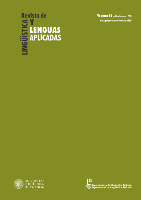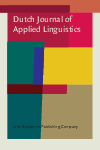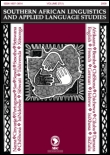
RAEL-Revista Electronica de Linguistica Aplicada
Scope & Guideline
Elevating Academic Discourse in Linguistics
Introduction
Aims and Scopes
- Applied Linguistics Research:
The journal emphasizes research that applies linguistic theory to practical language learning and teaching scenarios, including second language acquisition and language pedagogy. - Sociolinguistic Analysis:
It covers studies examining language use in social contexts, including politeness strategies, sociostylistics, and the impact of social factors on language. - Multimodal Communication:
Research that explores the integration of various modes of communication, such as verbal, visual, and digital, is a significant focus, highlighting the importance of multimodality in contemporary language practices. - Corpus Linguistics:
The journal encourages the use of corpus-based methodologies to analyze language patterns and structures, facilitating empirical research in linguistics. - Language and Technology:
There is a consistent interest in the intersection of linguistics and technology, including studies on machine translation, digital communication, and the use of computational tools in language research.
Trending and Emerging
- Gender and Language Studies:
There is an increasing focus on gender performativity and its implications for language use, reflecting a broader societal interest in gender issues within applied linguistics. - Pragmatics and Language Proficiency:
Research examining the interface between language proficiency and pragmatic competence is gaining traction, highlighting its significance in effective communication. - Digital and Visual Literacy:
Emerging themes in digital communication and visual literacy indicate a recognition of the evolving nature of language in the digital age, emphasizing the importance of multimodal approaches. - Language Learning in Diverse Contexts:
Studies exploring language learning experiences in varied demographic groups, such as senior learners or non-traditional students, are becoming more prominent, showcasing the journal's commitment to inclusive research. - Machine Learning and Linguistics:
The application of machine learning techniques in language research is on the rise, reflecting a trend towards integrating computational methods in applied linguistics.
Declining or Waning
- Traditional Grammar Studies:
There seems to be a decline in papers focused solely on traditional grammar analyses, as the journal shifts towards more applied and technology-driven linguistic research. - Linguistic Theory without Application:
Papers that primarily discuss theoretical linguistics without a clear application to language education or real-world contexts are becoming less frequent. - Static Language Acquisition Models:
Research that relies on static models of language acquisition is waning, as newer studies favor dynamic approaches that consider social and contextual variables.
Similar Journals

Revista de Linguistica y Lenguas Aplicadas
Unveiling New Perspectives in LinguisticsRevista de Linguistica y Lenguas Aplicadas, an esteemed journal published by UNIV POLITECNICA VALENCIA, EDITORIAL UPV, is a pivotal resource in the field of linguistics and applied languages. Since its inception, the journal has embraced Open Access publishing since 2006, ensuring that its rich repository of research is readily available to a global audience of researchers, academics, and language professionals. Headquartered in Valencia, Spain, the journal contributes significantly to the advancement of linguistics knowledge, boasting a respectable ranking within the Q3 quartile for Linguistics and Language (2023) according to Scopus metrics. It covers a diverse range of topics and methodologies, engaging readers through its commitment to scholarly rigor and innovation. The journal is uniquely positioned to inform and inspire essential discussions from 2015 to 2024, making it a vital platform for emerging linguists and seasoned scholars alike, as they explore the evolving landscapes of language and communication.

Revista Espanola de Linguistica Aplicada
Elevating discourse in linguistics and e-learning.Revista Espanola de Linguistica Aplicada is a prominent academic journal published by John Benjamins Publishing Co, specializing in the interdisciplinary fields of linguistics, education, and e-learning. With its ISSN 0213-2028 and E-ISSN 2254-6774, the journal has established a significant presence in Spain and beyond, showcasing innovative research and contributions in applied linguistics. The journal is recognized for its rigorous peer-review process and maintains impressive Scopus rankings, notably within the 72nd percentile for Arts and Humanities and 68th percentile for Social Sciences, reflecting its critical role in advancing the study of language and education. As of 2023, it holds a Q3 rank in Education and a Q2 rank in Linguistics and Language, underscoring its influence and relevance in these disciplines. Targeted at researchers, educators, and students alike, the journal aims to facilitate knowledge exchange and provide a platform for discussions that shape the future of linguistics.

Review of Cognitive Linguistics
Fostering Interdisciplinary Dialogue in Language StudiesThe Review of Cognitive Linguistics, published by John Benjamins Publishing Co, is a premier academic journal dedicated to the exploration of cognitive approaches to linguistics. With an ISSN of 1877-9751 and E-ISSN 1877-976X, this journal provides a critical platform for researchers and professionals to disseminate their findings in the rapidly evolving fields of linguistics and language, alongside developmental and educational psychology. Hailing from the Netherlands, the journal boasts impressive standing within the academic community, as indicated by its 2023 Q1 ranking in Linguistics and Language and Q3 in Developmental and Educational Psychology. Additionally, its Scopus rankings reflect a strong position within the arts and humanities and social sciences categories. While currently operating under a traditional access model, this journal actively contributes to the overarching discourse within cognitive linguistics, and is a vital resource for those aiming to deepen their understanding of the intricate link between language and cognition. Researchers, educators, and students are encouraged to engage with the rich body of articles spanning its convergence years from 2010 to 2024, making it an essential read for those at the forefront of these interdisciplinary studies.

Dutch Journal of Applied Linguistics
Unlocking Insights in Applied LinguisticsWelcome to the Dutch Journal of Applied Linguistics, a premier open-access publication dedicated to advancing the field of applied linguistics. Published by openjournals.nl and based in the Netherlands, this journal has been committed to disseminating innovative research since its inception in 2012, gaining recognition within the academic community for its rigorous scholarship and high standard of publications. With an impressive Q1 ranking in both the Linguistics and Language category and a commendable percentile standing in Scopus, the journal provides an essential platform for researchers, professionals, and students alike to explore the latest findings and developments in language studies. As an open-access journal since 2021, it ensures that valuable knowledge is freely accessible to a worldwide audience, fostering collaboration and enhancing the impact of research in this dynamic field. The Dutch Journal of Applied Linguistics invites you to contribute and engage with cutting-edge scholarship that shapes the future of language use and learning.

RUSSIAN LINGUISTICS
Illuminating the intersections of language and psychology.RUSSIAN LINGUISTICS is a peer-reviewed academic journal published by Springer, dedicated to advancing the understanding of the Russian language and its interplay with various linguistic frameworks. With a longstanding history that spans from its inception in 1974, the journal encompasses a broad range of topics within the fields of linguistics and language studies, offering valuable insights especially in *Developmental and Educational Psychology* and the intricacies of linguistics at large. Currently ranked in the Q2 quartile for Linguistics and Language, and holding substantial positions within Scopus rankings, RUSSIAN LINGUISTICS serves as an essential resource for researchers, educators, and students alike, fostering dialogue and collaboration within the international linguistic community. The journal notably provides critical access to research findings that enhance the comprehension of Russian linguistics' role in a global context, despite operating under a traditional access model. For those pursuing scholarly excellence, RUSSIAN LINGUISTICS remains a pivotal platform for disseminating innovative research and promoting the study of language.

LFE-Revista de Lenguas para Fines Especificos
Exploring Innovative Approaches in Applied LinguisticsLFE-Revista de Lenguas para Fines Especificos is a distinguished academic journal focused on the field of applied linguistics and language education, published by UNIV LAS PALMAS GRAN CANARIA, SERV PUBL & DIF CIENT PARQUE CIENT. Established in 1993, this Open Access journal promotes the dissemination of research on specific purposes in language studies, making it an invaluable resource for researchers, educators, and students alike. Based in Spain, it serves an international audience interested in the intersection of language acquisition, pedagogy, and professional communication. Despite its recent entry into Scopus with competitive rankings in Social Sciences, particularly in Linguistics and Language and Education, the journal aims to continually enhance its impact by inviting innovative contributions that explore contemporary challenges and methodologies in language teaching and learning. Researchers are encouraged to tap into this growing repository of knowledge, which is easily accessible to foster collaborative and interdisciplinary dialogues within the field.

Colombian Applied Linguistics Journal
Exploring the richness of language in Latin America.Colombian Applied Linguistics Journal, published by UNIV DISTRITAL FRANCISCO JOSE DE CALDAS, serves as a vital platform for the advancement of knowledge in the field of applied linguistics, particularly within the Latin American context. Since its inception in 2003, the journal has embraced an Open Access model, ensuring that cutting-edge research is readily accessible to scholars, practitioners, and students alike. With a focus on topics including language acquisition, language policy, and bilingual education, the journal contributes to the understanding of linguistic diversity and its practical applications in educational settings. The Colombian Applied Linguistics Journal is dedicated to fostering dialogue and disseminating research that bridges theory and practice, thus playing a crucial role in shaping contemporary discourses in linguistics and education. Located in Bogotá, Colombia, the journal encourages submissions from both national and international authors, enhancing its reputation as a key player in the global linguistic community.

Southern African Linguistics and Applied Language Studies
Advancing Linguistic Knowledge in Southern AfricaSouthern African Linguistics and Applied Language Studies is a prestigious journal dedicated to the exploration and analysis of linguistics and applied language studies within the Southern African context. Published by Taylor & Francis Ltd, this esteemed journal has established itself as a significant platform for scholars and practitioners since its inception in 2003. With an impressive Q2 ranking in the Linguistics and Language category and a current Scopus rank of #430 out of 1167, it occupies a vital position in the academic landscape, appealing to a diverse readership keen on linguistic research, language policy, and applied linguistics. While the journal is not currently open access, it provides comprehensive insights and scholarly articles that foster understanding and innovation in linguistic practices and language education. As of 2024, the journal continues to deepen its impact through rigorous peer-review and a commitment to advancing knowledge, making it a key resource for researchers, educators, and students seeking to navigate the complexities of language within the Southern African region and beyond.

RLA-Revista de Linguistica Teorica y Aplicada
Bridging the gap between linguistics theory and practical application.RLA-Revista de Linguística Teórica y Aplicada, published by Universidad de Concepción, Facultad de Humanidades y Arte, stands as a vital resource in the field of linguistics, delivering cutting-edge research and scholarly articles that contribute to both theoretical and applied linguistics. With its ISSN 0718-4883, this journal aims to foster robust discussions and innovations in linguistic theory, language acquisition, sociolinguistics, and applied linguistics methodologies. Although the journal currently does not provide open access options, it endeavors to reach a diverse audience, including researchers, professionals, and students, who are keen to explore the rich tapestry of language studies. By offering insights from both local and global perspectives, RLA does not only advance linguistic discourse but also encourages interdisciplinary collaboration, thereby solidifying its role as a pivotal publication in the linguistic academic community.

Argentinian Journal of Applied Linguistics
Bridging the gap between linguistic theory and real-world application.The Argentinian Journal of Applied Linguistics is a prominent publication dedicated to advancing the field of linguistics with a particular focus on practical applications within various contexts. Published by the Federación Argentina de Asociaciones Profesionales de Profesores de Inglés (FAAP), this journal serves as a vital platform for researchers, educators, and linguistics professionals interested in the nuances of language teaching, acquisition, and sociolinguistics. With an ISSN of 2314-3576, the journal showcases original research and reviews that push the boundaries of current knowledge and practice in applied linguistics. Despite being in its early stages, the journal aims to build a strong academic presence by fostering collaboration among scholars and practitioners, thereby contributing to the enhancement of language education in Argentina and beyond. The importance of this journal lies not only in its commitment to accessibility and knowledge dissemination but also in its role as a bridge between linguistic theory and practical application, ultimately benefiting educators and learners alike.